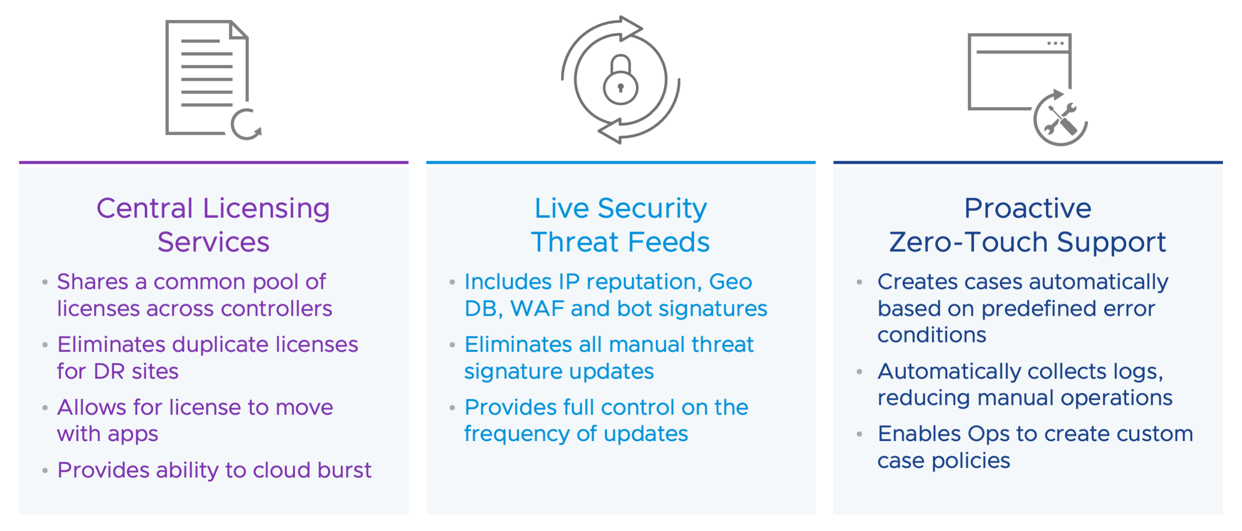NSX+ Advanced Load Balancer Cloud Services Solution Brief
CHALLENGES
- Resources and staff for deploying and managing load balancing infrastructure is limited
- Identifying system failures and collecting data to analyze issues and support requests takes a long time.
- Maintaining security posture with patching and signature updates is cumbersome
SOLUTION
- Centralized licensing service: capacity management with on-demand autoscaling that enables DR and cloud bursting use cases
- Proactive zero-touch support: automated case creation, help desk and anomaly detection
- Live security threat intelligence: curated signatures and security threats fed into WAF to protect web applications from attacks
BENEFITS
- Fast time-to-value: brings operational services to any customer environment with ease of operations and self service
- Operational simplicity: reduces complexity in capacity management, monitoring, handling backups, DR and troubleshooting
- Proactive resilience: proactively detects anomalies, autoscales capacity or creates support cases automatically without disruptions
Challenges with Traditional Load Balancing Approaches
Hardware load balancers or virtual appliances served traditional applications for decades. However, the prevalence of container and cloud technologies, has necessitated a new approach to both application delivery and consumption models. A few challenges created by traditional architectures include tedious manual provisioning and management of load balancers, lack of visibility to troubleshoot and resolve issues before user experience is impacted. Today’s distributed application delivery infrastructure needs to minimize application downtime, and the complexity of maintaining multi-cloud environments – from on-prem data centers to the cloud.
Simplify App Delivery with Multi-Cloud Application Services
Based on a software defined architecture with on-demand autoscaling and per-app/per-tenant deployments, Avi provides a resilient, self-healing application services fabric that elastically scales to handle unpredictable peak loads and delivers high availability across clouds. Regardless of customer’s choice – managing their own Avi Controllers and deploying Avi Service Engines closest to the applications or getting hosted controller services from VMware – Avi with Cloud Services provides a consistent set of application services including local and global load balancing, web application firewall (WAF) and container ingress. Avi PULSE Services connects with Avi Controller to provides a set of operational services (see Figure 1) to simplify operations, accelerate time-to-value, and provide proactive support and resilience.

Figure 1: Avi with Cloud Services Deployment Architecture
BENEFITS
Avi with Cloud Services provides automated software upgrades, proactive support for faster resolution of faults detected, vulnerabilities, and capacity recommendations with minimal disruption to ensure application availability, security, and responsiveness. Administrators have access to all analytics on app performance, end-user interactions, and security events in a single analytics dashboard for complete end-to-end security insights, security intelligence and enforcement. Customers realize the following benefits by deploying Avi with Cloud Services (see Figure 2).
|
|
|
|
|
Fast Time-to-Value Deployment/Installation Multi-tenancy Day 0 automation Self-service |
Operational Simplicity Software upgrades Health monitoring Backups and handling DR Faster troubleshooting |
Proactive Resilience Anomaly detection Reduced misconfiguration Auto sizing and scaling HA and self-healing |
Figure 2: Avi with Cloud Services Benefits
FEATURES
Avi PULSE Services includes the following services (see Figure 3)
- Centralized licensing service offers dynamic load balancing capacity management so that customers can react to the changing needs to their applications in real time by shifting unused capacity from one site to another, whether those loads are deployed on premise or in the cloud. It enables the cloud bursting use case and DR with fast automatic failover.
- Live security threat update feeds daily updates into the WAF to get the latest curated signatures from trusted sources.
- Proactive Zero-touch support provides automated help desk and ticket management systems. It proactively monitors the load balancing environment(s) and automatically registers a support ticket with the VMware support team and generates alarms and logs as soon as anomalies or issues are detected.

Figure 3: Avi PULSE Services Features
Avi with Cloud Services requires an always on connection from the on-prem deployment to automatically gets security updates, handles support case information, and manages licenses for flexible capacity planning. Moreover, it allows customers to simplify operations through continuous security signature updates, and the ability to provide expediated resolution to any issues or outages in the application environment.



